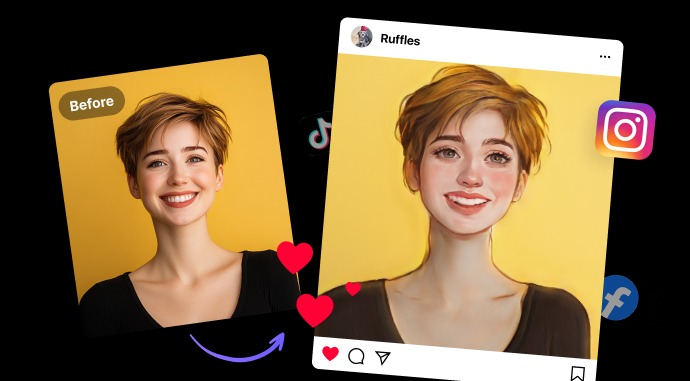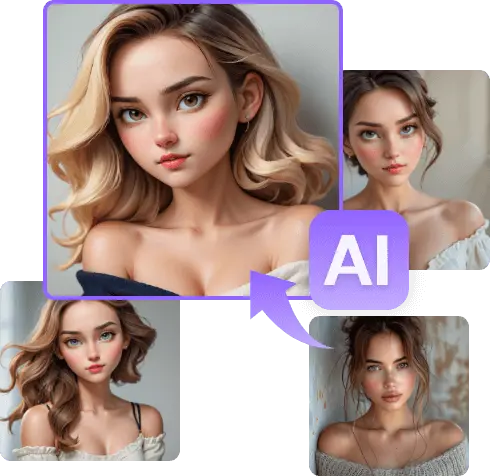The Snap to Laughter Application Creates Caricatures from Your Pictures
Your facial shape resembles what funhouse mirrors produce. The collection of distinctive features transforms into fun distortions through the process. The application transforms regular pictures into animated page designs through its funny sketch processing. The artistic creation presents both fun and unexpected joy through its production.
Choose any picture that holds special meaning to you. A sharp quality in your picture selection will bring positive results. Light-toned backgrounds produce the best results in this process. You can make the face visible through the background selection you made. A proper foundation stands as a necessary requirement for every caricature.
Start your project by operating drawing or photo editing tools. Users can try out convert photo in caricature. Review multiple sketch procedures by layering colors throughout your artwork. The software application allows users to alter both lines and shapes through its menu system. Option selection on your image allows you to activate cartoon filters. Each filter expands your dimensions without altering your facial recognition.

Digital pens or mice are necessary to acquire for the next step of the process. Trace over your photo slowly. An accidental mistake can appear during the drawing tracing process. A small writing error with a pen usually results in comical effects. The main priority throughout the procedure consists of strengthening the characteristics of the face. And as a next step you should extend the size of your eyes and widen your smile. These modifications give rise to the active character of the caricature.
Your artwork should be divided into separate areas while you are drawing. You should draw each key feature separately rather than simultaneously. Spend a minute on the eyes. The features of the nose should follow the mouth in drawing order. When artists modify proportions the features end up appearing comical. Have you ever watched cartoons through animated movies as a kid? Audiences remember these characters because their facial characteristics received aggressive modification.
Select artists make use of applications that conduct multiple artistic operations automatically. The smart filters of these programs provide users with immediate options for proportion control. The artists combine modern technological advances with their artistic visionary approach. It can be a real time-saver. The production rate increases yet a human author maintains essential status. End your piece with hand-made illustration elements added to reach the intended ironic effect during later stages of work completion.
Color selection is a blast. Overall caricatures use unconventional vibrant colors when creating their visual elements. Pick hues that pop. For the outside areas of conventional borders select color choices which exceed what you would typically choose for yourself. Through this process the expression develops into a valuable artistic composition that discloses narrative aspects. The punchline role belongs to colors that finalize the humorous element in your work.
The outline stands as the most effective tool to help you succeed. Every one of your pencil marks can function without reaching flawlessness. Light imperfect features located along the artwork boundaries create an attractive visual effect. The image develops a rough playful visual impact because of these elements. The artwork displays these irregularities because you created the sketch after midnight hours. The incomplete lines in your caricature bring both spontaneous feeling and vitality to the artwork.

Caricature Magic: Turning Photos into Playful Art
According to principles of creativity and technological methods artists convert photos into cartoon or caricatures. Programmers work together with artists to create amusing facial distortions which result from their techniques. Computers need thousands of training images or basic filters to produce this transform.
Face detection functions as one of the first processes within this system. A system examines both mouth shapes and nose shapes together with eye shapes and produces visual outlines of the detected features. These regions get separated from each other by identification system methods which perform pattern recognition. With all landmarks identified the software application initiates its twisting and exaggeration process. A computer system applies warping techniques by selecting points for modification on the nose followed by eye enlargement functions. Radical deformation functions best on the face because it serves as an optimal surface for this purpose.
Two kinds of software tools use filter technology to convert photos int
o cartoonized images. The image filters perform simultaneous evaluation of light variations and spatial edge definitions found in images. Software tools employed by computers identify image edges in order to increase their visibility while elevating important visual components. The technique duplicates the artistic practice of applying powerful lines while sketching. These methods generate amusing character by studying the facial expression. The filter produces reflective distortions of your facial features through its operating mechanism.
Platform software generates realistic hand-drawn visual outputs through execution of programmed instructions. Virtual expertise in caricature creation serves as the operational principle of this software. The application software conducts a transformation process which generates ink drawings containing color. Every line within the virtual system gets recorded for digital enhancement processing. Artistic elements in the concluding drawing transition from realistic styles to generate distinct and whimsical art pieces. Operating developers execute this technique by merging it with shading effects at times. The proportional modifications of the caricature maintain its artistic depth without compromising any aspect while changing proportions.

During recent times deep learning technology brought new developments to various fields. The training of machine learning networks relies on extensive art sketches collected from the source material. Processing algorithms require many years of practice to learn patterns produced by humans. The trained models apply their learned exaggeration methods to new pictures after completion of their training phase. The significant amount of practice enables students to replicate the artistic style of famous painters in identical ways. Previous sample data enables the computer to perform modifications on color and curve and contrast settings. Automated methods provide artists with a speedy solution to design cartoon illustrations without requiring repeated testing activities.
Standard style transfer techniques base their operations on altering image features. When implementing style transfer on an image it accepts artistic styles obtained from multiple art masterpieces. The software melds the original photo with an artistic overlay. The software both enhances color saturation and applies strong brush strokes during its processing operation. The outcome displays important elements from the original subject while it incorporates artistic qualities from modern era artwork. The artistic visual effect emerges from merging selfie contents with comic book dynamic features. The transformative procedure leads original photos to become something unexpected and makes familiar objects hold different meanings altogether.
